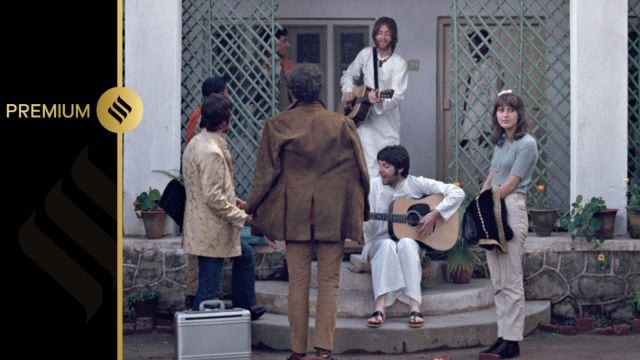1968, a John Lennon love story: Beatles Ashram in Rishikesh set for a makeover
It was here that the iconic British band spent nearly a month, meditating and writing some of their most popular songs
 The Beatles during their stay at the ashram in 1968.
The Beatles during their stay at the ashram in 1968.In the February of 1968, a lovestruck John Lennon would go on early morning walks to the post office on the premises of Chaurasi Kutiya, a retreat in Rishikesh on the banks of the Ganga where he and the other members of the Beatles band practised yoga guru Mahesh Yogi’s Transcendental Meditation. His post office walks, as his wife Cynthia who accompanied him on that India visit would later realise, was to check if singer Yoko Ono, with whom he was in a relationship, had sent him a telegram.
Inside one of the meditation huts of the now abandoned Chaurasi Kutiya ashram is a pop art that immortalises this love story – a line from Yoko’s telegram to Lennon that reads, “Look up at the sky and when you see a cloud, think of me.”
Lennon’s fledgling love story, one of the many priceless nuggets from the Beatles’ India stay in 1968, will now come to life as the Uttarakhand government plans to renovate the ashram. It hopes to turn the 17-acre space – with a string of concrete, double-storey hobbit houses, pathways overrun by weeds and deserted buildings – into an ‘International Heritage Tourism destination’.
 The Beatles during their stay at the ashram in 1968.
The Beatles during their stay at the ashram in 1968.
Standing on the banks of the Ganga, the ashram is now a space frozen in time. Under tall trees and amid patches of wild canna plants are the buildings and meditation centres of Mahesh Yogi’s Chaurasi Kutiya, which after the Beatles’ 1968 stay became popular as the Beatles Ashram. The iconic British band spent nearly a month here, meditating and writing at least 30 songs, including those from The Beatles (White Album) released later that year.
For the Ahmedabad-based HCP Design, Planning & Management Pvt Ltd, which is executing the renovation project, this is the second ashram project after the Gandhi Ashram Redevelopment Project in Gujarat. Helmed by architect Bimal Patel, the firm has handled several high-profile projects, including Central Vista and the new Parliament building in Delhi, and the Kashi Vishwanath corridor project in Uttar Pradesh.
According to Anand Patel, project head at HCPDPM, “The project is expected to commence by the end of 2024. It will take about 18 months to be completed at an estimated cost of Rs 90 crore.”
Inside the ashram
Part of the Rajaji Tiger Reserve, on the eastern banks of the Ganga, the ashram was set up by Mahesh Yogi in 1963, with his Transcendental Meditation Teacher Training Course attracting participants from around the world. He is known to have built it with a USD 100,000 grant from American heiress Doris Duke.
 The gallery with photos of the Beatles taken by Paul Saltzman, a Canadian filmmaker and television producer, at Chaurasi Kutiya. (Express photo by Leena Misra)
The gallery with photos of the Beatles taken by Paul Saltzman, a Canadian filmmaker and television producer, at Chaurasi Kutiya. (Express photo by Leena Misra)
Among the most famous visitors to the ashram were the Beatles, who were then famously embarking on a journey from psychedelia to transcendence. In February 1968, John Lennon, George Harrison, Paul McCartney and Ringo Starr arrived at the Rishikesh ashram accompanied by their wives and their manager. Here, they wrote some of their most popular songs, including ‘Back in the USSR’, ‘Dear Prudence’, ‘Julia’ and ‘The Continuing Story of Bungalow Bill’.
 Constructed in 1976 at Chaurasi Kutiya in Rishikesh, Ved Bhavan was used as a lecture hall and to conduct classes.
Constructed in 1976 at Chaurasi Kutiya in Rishikesh, Ved Bhavan was used as a lecture hall and to conduct classes.
Chaurasi Kutiya gets its name from the 84 meditation rooms – 42 each on either side of a yoga centre. The complex has nearly 25 buildings, most of which are in a dilapidated state, including the sprawling bungalow that Mahesh Yogi lived in while at the ashram. Though it’s unclear when he left the ashram, the spiritual guru died years later, in 2005, in the Netherlands.
Among the few buildings that are relatively untouched by time are the unique pyramid-shaped Anand Bhavan and Siddhi Bhavan, built in 1976, which served as residences for those training to be teachers of Transcendental Meditation.
Inside the ashram, the story of the Beatles is told through a gallery with over 20 photographs taken by Paul Saltzman, a Canadian filmmaker and television producer who chronicled the Beatles’ stay.
A striking feature of the ashram is the series of concrete huts, which served as meditation caves for “sanyasis and brahmacharis”. The walls of the 121 huts, built in 1976-78, are embedded with round pebbles sourced from the river banks. Each of these huts have a narrow, winding stairway that leads to the floor above. As per the renovation plan, at least 20 of these huts will be refurbished for people to use as meditation spaces.
Keeping a legacy alive
It was in 1961 that land for the ashram was leased to Mahesh Yogi by the then Uttar Pradesh government. After the 20-year lease expired in 1981, the place was taken over by the state government. While the ashram remained abandoned, its Beatles connection continued to draw visitors.
In 2015, the Uttarakhand forest department took over the ashram, which is the only part of the Rajaji Tiger Reserve that is open through the year. That year, the ashram reported 20,000 visitors, which spiked to 35,000 in 2018 when Paul McCartney came to celebrate 50 years of the Beatles’ visit to Rishikesh. The ashram saw more tourists in June 2023, when the Uttarakhand government, which had hosted a three-day Infrastructure Working Group (IWG) meeting in Rishikesh as part of the G20 summit, took the delegates to the ashram. That year, the number of visitors rose to 45,000.
 The printing press at Chaurasi Kutiya. (Express photo by Leena Misra)
The printing press at Chaurasi Kutiya. (Express photo by Leena Misra)
A vision document for the redevelopment has been readied and is now with the Public Works Department (PWD) of the Uttarakhand government for vetting, a state government official told The Indian Express.
Uttarakhand Forest Minister Subodh Uniyal said not much of what is inside the ashram will be disturbed. “The plan is to keep it in as-is condition. The idea is to preserve the legacy of the Beatles,” he said.
Though the project is being undertaken by the state tourism department, the area falls in the jurisdiction of the forest department as it is part of the reserve forest that is a habitat for tigers and elephants, among other protected species.
Conservator of Forests & Director of Rajaji Tiger Reserve, Koko Rose, told The Indian Express, “Around 9-13 buildings will be refurbished – the Maharshi’s bungalow, the building where the Beatles stayed, the Vedic kitchen. There will be no new construction and no razing. The idea is to enhance the tourist experience. Being a forest area, nobody will be allowed to stay overnight, play loud music or do anything that could disturb the wildlife.”
 Anand Bhavan served as the residence for those training to be transcendental meditation teachers. (Express photo by Leena Misra)
Anand Bhavan served as the residence for those training to be transcendental meditation teachers. (Express photo by Leena Misra)
The kitchen, which whipped up meals for some 500 people when the ashram was at its peak, is among the spaces that are being renovated.
HCP’s Anand Patel said the centre would be open to visitors only during daylight hours and will be a “low-impact tourism destination”.
“A cafeteria, a museum shop and administration office will be housed in the renovated buildings. The other buildings will have exhibitions on the Maharishi, Beatles and the Rajaji National Park. We plan to repair and restore 12 of the 25 buildings on the site. All the remaining buildings will be left as they are to serve as a memory of the time gone by,” he said.



- 01
- 02
- 03
- 04
- 05




























